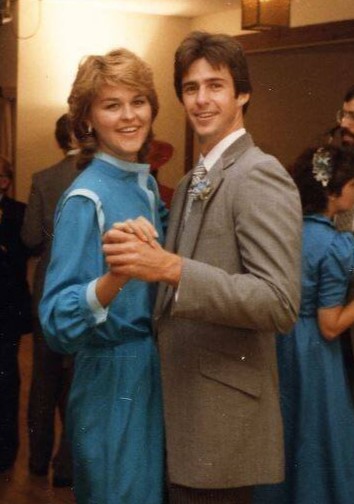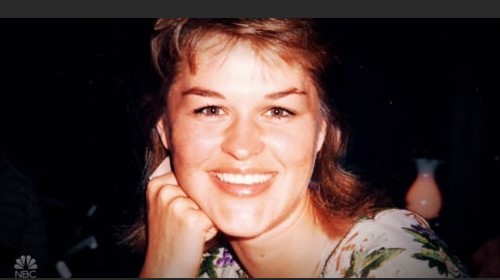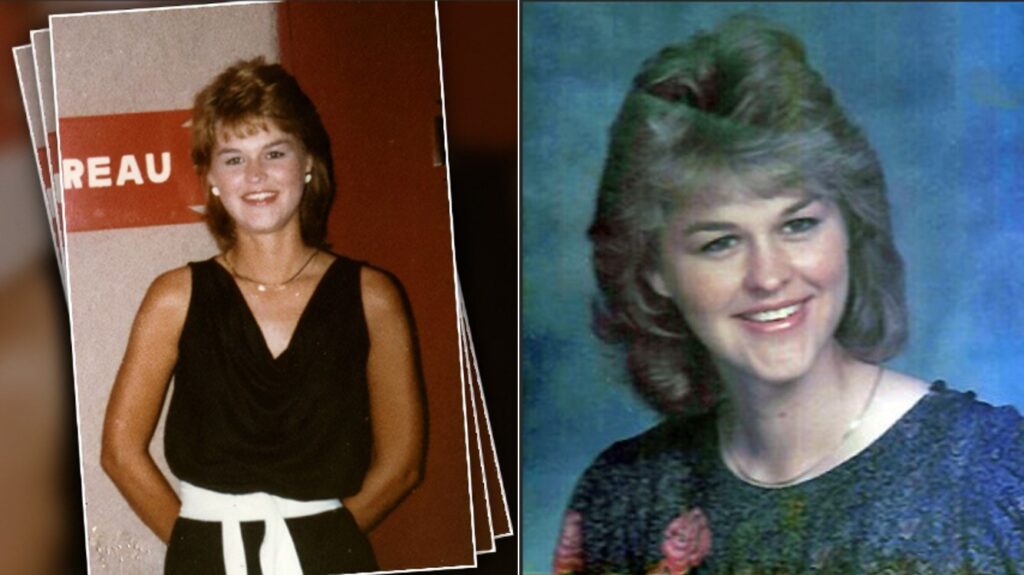
Investigation Reports: Nurse Sherri Rae Rasmussen was believed to be killed in a home invasion. However, a rising female officer of the LAPD hid a dark secret. She was later convicted of murdering her college crush’s new wife and staging the crime scene to make it look like a burglary.
The Murder of Sherri Rasmussen

In 1986, Sherri Rae Rasmussen was 29 years old, living in a condominium with her new husband of three months, John Ruetten.
On the night of February 24, her husband came home to discover his new bride, who had stayed home from work that day after injuring her back doing aerobics, bloodied, beaten and dead from numerous gunshot wounds to the chest.
Rasmussen suffered three gunshot wounds. A trajectory analysis showed that two additional gunshots went through the sliding glass door in the dining-kitchen area.
The death of Sheri Rasmussen was terrible loss to her family and husband.

The Rasmussen homicide occurred on February 24, 1986. However, Police Officer Lazarus was not arrested until June 5, 2009, 23 years later.
As a cop, Stephanie Lazarus murdered her ex-boyfriend’s wife. She’s now recommended for parole (Los Angeles Times, November 16, 2023)
The Murder of Sherri Rasmussen
In 1986, Sherri Rae Rasmussen was 29 years old, living in a condominium with her new husband of three months, John Ruetten.
On the night of February 24, her husband came home to discover his new bride, who had stayed home from work that day after injuring her back doing aerobics, bloodied, beaten and dead from numerous gunshot wounds to the chest.
Rasmussen suffered three gunshot wounds. A trajectory analysis showed that two additional gunshots went through the sliding glass door in the dining-kitchen area.
The 1986 Homicide and Initial Investigation
In February 1986, Sherri Rasmussen and John Ruetten had been married three months. Rasmussen was 5’10 and about 150 pounds and very fit and strong because she worked out regularly. The couple lived in a town house in a condominium complex in Van Nuys. Their unit had an attached garage under the living area accessible by a set of stairs from within the front entryway of the residence. At about 7:20 a.m. on the morning of Monday, February 24, 1986, Ruetten went to work as usual, leaving by the door to the garage.
Rasmussen was the head nurse of the coronary care unit at Glendale Hospital. However, she did not get out of bed for work that morning and decided to stay home because she wasn’t feeling well. Ruetten and Rasmussen’s sister tried to call her several times through the day, but the calls were picked up by an answering machine.
Ruetten returned home at around 6:00 p.m. When he drove up, their garage door was open, Rasmussen’s BMW was gone, and there was broken glass near the garage entrance. Ruetten went up the stairs and found the door from the garage ajar that he had locked when he left. Inside, stereo equipment was stacked by the door to the garage that had been kept in an entertainment center in the living room. Rasmussen lay on the living room floor in her bathrobe and night shirt, dead from apparent gunshot wounds to her chest.
Ruetten called the police. Multiple officers, paramedics, and investigators from the LAPD and county coroner responded to investigate and to collect evidence.
LAPD Detectives Lyle Mayer and Steven Hooks handled the 1986 homicide investigation. The town home had an upper floor with a master bedroom, a guest bedroom, a study, and two bathrooms. There was no sign of a struggle upstairs or that property, including a jewelry box and additional stereo equipment, had been disturbed. Physical evidence from the lower level included two bullet holes through the middle of a closed curtain and out a sliding glass door in the kitchen/dining area off the living room.
Near Rasmussen’s body in living room, police found a snuggie type blanket on a chair with apparent gunshot residue. Some shelves in an entertainment center were collapsed and a stereo speaker from there lay on the floor in front of Rasmussen’s head. The drawer of a living room table had been pulled out and the contents dumped onto the floor. A broken porcelain vase and a white towel lay to the left of Rasmussen’s body. From the entryway by the front door, investigators collected samples from blood spatter on the floor, the wall by an electrical outlet about a foot of the floor, and midway up a closet door. They also found two broken fingernails on the floor, and multiple latent fingerprints. They photographed a bloody fingerprint and palm print on a CD player stacked with a VCR by the door to the garage. They recovered a fingerprint on the banister of the stairs to the garage and a sample of apparent blood on the wall in the stair well.
Investigators lifted 23 fingerprints from the crime scene. Several came from Rasmussen, Ruetten and one from a family friend. However, seven identifiable fingerprints could not be attributed to them, including fingerprints near blood in the entryway where Rasmussen fought with her assailant.
At around 9:30 a.m. on the morning of the incident, a neighbor went by Rasmussen’s garage and saw the door open and no cars inside. At around 4:40 p.m. that afternoon, two gardeners brought the same neighbor a purse they found on the grounds of the condominium complex. Rasmussen’s wallet and driver’s license were inside.
Evangelina Flores worked as a housekeeper in the unit next door to Rasmussen’s unit in the condominium complex. At around 12:30 p.m., Flores heard a sound coming through the wall from Rasmussen’s residence. It sounded like two people fighting followed by a scream, two loud thuds or booms, and a door slamming. After that, everything was silent until Flores heard a car drive off.
The Rasmussen-Ruetten unit had an alarm system. However, they only activated it a night when they went to bed. The front door had three locks: an interior deadbolt, a key lock deadbolt, and a standard door handle lock. There was no damage to the front door locks or door indicating a forced entry or tampering with the locks apart from some scratches on the door jamb.
When Ruetten went to work via the door to the garage on the day of the homicide, he did not check and did not know whether the front door was locked when he left.
In 1986, Detectives Mayer and Hooks concluded that the homicide was part of a burglary gone awry. The initial evidence indicated that probably two suspects entered through an unlocked front door. Rasmussen surprised them while they were burglarizing the condo and a violent struggle over a gun ensued.
On the day after the crime, Nels Rasmussen (the father of the victim Sherri Rasmussen) identified Lazarus as a Suspect and Police Officer and asked Detective Mayer if he had checked her out.
Eleven days later on March 7, 1986, the police found Rasmussen’s BMW abandoned on a street in Van Nuys about 2½ miles away from her residence. The keys were in the ignition and no parts were stripped from the car. LAPD evidence technicians collected samples of apparent blood from around the ignition and interior driver’s door handle and five fingerprints from the seat belt connector and the driver’s and passenger’s windows.
About three weeks later and again on November 19, 1986, Ruetten mentioned Lazarus to police investigators as his former girlfriend and police officer when they told him about the bite mark on Rasmussen. In December 1986, Rasmussen’s mother also told Detectives Mayer and Fisk that they should investigate Ruetten’s former girlfriend. The three people closest to Sheri Rasmussen had identified Lazarus as a suspect in 1986.
From his initial interview with police, Sherri’s father, Nel Rasmussen repeatedly told detectives about several stalking and threatening incidents Sherri experienced involving an ex-girlfriend of Ruetten’s, who was also an LAPD officer. Nel never knew Lazarus’s name and detectives continually rebuffed his theories and at one time saying he “…watched too much TV.”
In one instance, Rasmussen came home to find Lazarus, in full uniform, standing inside the home she shared with her husband.
In another incident Nel recounted, Lazarus showed up at Glendale Adventist Hospital in uniform and gave Rasmussen a threatening warning about Reutten, “If I can’t have John, nobody can.”
One of Sherri’s coworkers at Glendale Adventist Hosptial, Sylvia Nielsen witnessed a confrontation between her and an ‘unknown person’ at the time.
Days before she died, Rasmussen told her father she believed the same female officer had been following her on the street.

Sherri Rasmussen’s Autopsy
An autopsy two days later determined that Rasmussen had been shot three times in the chest, each shot a fatal wound. The coroner recovered three bullets from Rasmussen, one from under the skin of her back and two from the clothing under her back. One of the gunshots was a contact wound to the chest. On the inner, left forearm, there was an injury with two semi-circular patterns consistent with a bite mark. A coroner’s investigator had swabbed the apparent bite mark at the crime scene. Cathy Law, M.D., the chief forensic dentist with the Los Angeles County Coroner, examined the photographs of the marks on the arm. There were no teeth marks and Dr. Law could not say for sure it was a bite mark. The coroner had made a cast of the marks on the arm.
Rasmussen also had abrasion injuries around both wrists consistent with the pattern from a rope or a cord. A white cord/rope with apparent blood was found near the stereo equipment by the door to the garage. There were contusions to the right side of the face around the right eye, right ear and adjacent scalp, a laceration on the inside of the upper lip, and abrasions to the chin. The coroner could not determine the time of Rasmussen’s death because there were too many variables. A criminalist examined a sexual assault kit with evidence samples from Rasmussen and found no evidence of a sexual assault.
Modus Operandi—The Burglaries
Detectives Mayer and Hooks concluded that burglars committed the crime. The detectives relied not just on evidence of drawers opened and stereo equipment stacked ready to be taken away. They also “looked at similar crimes in the neighborhood” for modus operandi evidence.
Beginning with opening statements, a question arose several times during trial about whether the defense could cross-examine witnesses and present evidence to show that on April 10, 1986, an armed residential burglary with the same modus operandi occurred at a nearby condominium that was “almost an exact replica” of Rasmussen’s condominium.
To show common modus operandi or to draw an “inference of identity” other crime evidence “need not depend on one or more unique or nearly unique common features; features of substantial but lesser distinctiveness may yield a distinctive combination when considered together.” (People v. Scott, supra, 52 Cal.4th at pp. 472-473, accord People v. Lynch (2010) 50 Cal.4th 693, 736.)
Carl Olson worked for the Santa Monica Police Department as their records manager. He reviewed records and determined that on March 9, 1986, there were two additional auto burglaries from parking structures in the same area where Lazarus on the same day reported the theft of the revolver from her car after tampering with the door lock. In Lazarus’s daily planner there was a note on March 17, 1986, to “[t]ake in car.”
On April 11, 1986, Detective Mayer went to a similar condominium complex nearby to investigate another daytime burglary. The victim (Lisa Rivalli) would testify that she surprised two burglars who had stacked stereo equipment by the door to the garage and one threatened her with a .38 caliber revolver, but Rivalli was able to run away.
Detectives Mayer and Hooks received information of a daytime residential burglary (the “April 10th burglary”). They went to the scene and interviewed the victim Rivalli’s residence was a condo and almost an exact replica of Rasmussen’s location. Both are condos with security gates, both have security lock type entrances. Both have subterranean garages that have stairs leading up to the condo from the inside of the garage. In this burglary the suspects, once inside the location immediately stacked stereo equipment by the garage stairs door.
One of the suspects had a possible .38 caliber revolver during the burglary. The suspect actually pointed the gun at Rivalli and very possibly would have shot her had she not turned and ran away from the location. On the morning of the incident, Rivalli was home asleep at around 9:00 a.m. when the doorbell rang. She went to the front door and through the peep hole saw a Latino male outside who she didn’t recognize. Around noon, Rivalli left her condo to get something to eat. She saw a Latino male sitting in a Ford station wagon. She returned at around 1:00 p.m. and noticed the same Ford, now empty, parked nearby, and someone had put paper in the lock of the security gate for the complex.
When Rivalli put her keys in the front door, it opened, and she realized that it had been forced open. As she stood at the threshold, she saw the man from the Ford stacking stereo equipment on the floor next to the inner door to the garage stairs. She yelled at him, and he fled past her. A second man then came down from upstairs. “He had a gun in his right hand. It looked like a .38 caliber revolver. He pointed it directly at me. I was scared he was going to shoot me. I ducked down, turned around, and ran away from the complex.” The man then ran away and out the security gate for the complex. Miscellaneous jewelry valued at about $300 was stolen from Rivalli’s residence. The detectives concluded that the suspects could be the same persons who committed the burglary/murder at Rasmussen’s home.
No Direct Link Found Between the Two Burglaries
The trial court concluded that the evidence of the April 10th burglary was inadmissible evidence of third-party culpability. The court recognized “some general similarities.” Both occurred during the daytime and involved stereo equipment. The second suspect coming down the stairs pulled a “small gun” that he pointed at the victim who ran away. However, there were also “several dissimilarities.” Jewelry was taken at the April burglary. It “likely involved suspects going to the master bedroom in the upstairs.” A jewelry box was pried open, dresser drawers rummaged, and a hope chest opened. In the Rasmussen incident, no jewelry was taken, and the master bedroom was undisturbed. A principal dissimilarity was that the April 10th burglar left in a car. However, someone took Rasmussen’s car. The front door was forced open on April 10th but not at Rasmussen’s residence. The viciousness of the attack on Rasmussen with a contact gunshot to the chest reflected a clear intent to kill. That was missing from the April burglary. The court found “the critical feature is that there is nothing that links the suspects in the April 10th, 1986, burglary to the incident involving Ms. Rasmussen.”
The other dissimilarities found by the trial court were also insufficient to prevent jury consideration of the evidence. The court noted that the door had been forced at Rivalli’s residence but not at Rasmussen’s residence. However, Ruetten did not check and did not know whether the front door was locked when he left via the door to the garage that morning. The court also noted that the perpetrators on April 10th apparently left in their own vehicle, but Rasmussen’s car was taken. However, the perpetrator fired three gunshots at Rasmussen. Therefore, he had reason to take a readily available vehicle to avoid apprehension. Finally, the court found clear evidence of an intent to kill from contact gunshot wound to Rasmussen’s chest. However, it found “no evidence of any clear intent to kill on the part of the burglars on” April 10th and no shots were fired. However, the victim on April 10th came to her residence from outside. When the man came downstairs and pointed a gun at her, she was able to duck and run back out the open door. As noted, the evidence shows Rasmussen surprised the burglar(s) from inside the residence where a violent encounter ensued and escalated into a shooting.
Discovery showed that the police had reason to investigate Lazarus beginning February 25, 1986, the day after the homicide. On that day, Nels Rasmussen discussed his daughter’s case with LAPD Detective Mayer (the lead investigator) in the presence of Sherri’s husband John Ruetten. Nels Rasmussen told Detective Mayer that Sheri had been threatened by Ruetten’s former girlfriend who was a LAPD officer.
Several incidents took place even before the murder, that sparked concern in Sherri Rasmussen in regard to the jealous and intimidating Stephanie Lazarus. Lazarus harassed her at her workplace and showed up uninvited to their house.
Although the police examined numerous suspects in 1986, they made no arrests and the case remained open.

The Cold Case Investigation
In 2003, the case was re-examined as part of a slew of cold cases dating back to the 1960s.
No work was done on the case after 1986 until 2004 when LAPD “cold case” personnel reopened the investigation.
On December 20, 2004, LAPD contacted the coroner’s office to locate the bite mark swab from February 1986. After two days of searching multiple freezers in the evidence room, coroner’s personnel found a torn envelope with a swab tube protruding through a hole in an envelope with notations by a coroner’s investigator from February 25, 1986.
On December 30, 2004, the coroner’s office released the bite mark swab evidence to the LAPD.
DNA evidence revealed saliva found on the victim’s body belonged to a woman and not a man. After eliminating another female suspect, the police focused on Lazarus. An undercover officer was assigned to follow her and finally collected DNA samples from the veteran officer.
They interviewed Ruetten, Rasmussen’s roommate before Ruetten, and Rasmussen father and developed evidence that Lazarus had verbal arguments with Rasmussen about Ruetten. The police also found evidence that in 1984 Lazarus had registered a .38 caliber Smith & Wesson Model 49 revolver and reported it stolen on March 10, 1986.
Lazarus’s Love Obsession with John Ruetten
Ruetten met Lazarus at UCLA in the late 1970’s when they both lived in the same dorm. During college, they were romantically involved but not exclusively and not intimate.
In 1978, John Ruetten was 18 years old and a freshman at the UCLA. John was very handsome, talkative and charming, he was a fitness fanatic who had a great body and people have remarked how he looked like a male model.
John had many girls chasing after him and trying to get his attention. Like most teens, John also liked to party. Being that this was college, there wasn’t a shortage of them and it was at one of these parties in 1978, where he first encountered a girl, called Stephanie Lazarus.
Like John, Stephanie was also a freshman at UCLA, she was studying political science. They got to talking and realized that they had a few things in common; the main one being that they were both heavily focused on working out and physical fitness.
Eventually, the two of them began dating, but still, John never considered Stephanie his girlfriend. Both of them have said it was a strange relationship they had, Stephanie obviously hoped it would turn into something more, but John never seen her that way. He certainly didn’t want to make her his girlfriend. This didn’t stop Stephanie though; her behavior became more and more obsessive with him. She would often steal John’s clothes whilst he showered and would also take photographs of him naked whilst he slept.
After college, John accepted a job with hard-drive manufacturer Micropolis whilst Stephanie applied to the city’s police academy and became a uniformed officer with the Los Angeles Police Department in 1983.
The two remained in contact; however, it was clear to everyone that although John never had any real feelings for Stephanie, she was growing more and more infatuated with him.
In June 1984, Ruetten met Sherri Rasmussen at a party and soon started dating her exclusively. In May 1985, they became engaged. Ruetten told some friends who were also friends of Lazarus that he and Rasmussen were engaged.
In June 1985, Ruetten received a call from Lazarus. She was very upset and crying like he hadn’t heard before. He had not spoken to her since he started seeing Rasmussen. Lazarus asked Ruetten to come over to talk. He went to Lazarus’s condo and found her upset and crying. For the first time, Lazarus told Ruetten that she was in love with him. She was upset that Ruetten was getting married and moving on. Lazarus asked Ruetten to have sex with her and Ruetten did so because he felt bad that she was so upset, and he didn’t know how to calm her down. However, he made it clear that he was going to marry Rasmussen. A week or so after being with Lazarus, Ruetten moved in with Rasmussen in her condo.
One evening, Rasmussen came home from work upset. Mike Hargreaves, a fellow police officer and Lazarus’s roommate at the time, said that Lazarus told him she went to the hospital to see the woman Ruetten was going to marry and they had a confrontation. Ruetten then told Rasmussen about his last meeting with Lazarus when she was upset, and they had sex. Rasmussen already knew about that. Nevertheless, after talking they resolved to proceed with getting married. After their June 1985 meeting, Ruetten had no further contact with Lazarus.
On June 4, 1985, Lazarus wrote in her journal, “I really didn’t feel like working. I found out that John is getting married. I was very depressed. This is very bad. My concentration was negative 10.” On June 16, 1985, Lazarus stated: “I really didn’t feel like working. Too stressed out about John. I’ve had a real hard time concentrating these days and so I called up and said I didn’t feel well, and could I have a T.O. [Time Off] They gave it to me.”
In August 1985, Lazarus wrote Ruetten’s mother that she was “truly in love with John and this past year has really torn me up. I wish it hadn’t end[ed] the way it did and I don’t think I’ll ever understand John’s decision.”
On December 12, 1985, Lazarus received a letter from Ruetten’s mother. Lazarus wrote in her journal that “[t]his made me very, very, very sad.” Lazarus’s journal continued to the end of August 1986. However, there were no further mentions of Ruetten after December 1985.
Police work sheets showed that Lazarus was off duty on Monday, February 24, 1986, the day of the homicide, and on the Monday the week before (February 17, 1986) and the week after (March 3, 1986).
On the day of the homicide (February 24, 1986) Lazarus wrote “day off” in her daily planner, mentioned “Jean Pierre”, and made a note to call “Mike.” The police were was unable to determine who these people were.
Jayme Weaver worked the day watch with Lazarus the day after the homicide (February 27, 1986) and they used the same to locker room to change into their uniforms. The only thing Weaver remembered Lazarus saying about “John” was that he had been a college boyfriend, and their relationship didn’t work out.
Lazarus did not contact Ruetten after Rasmussen was killed on February 24, 1986.
About three years later in 1989, Ruetten called Lazarus when he learned that she and a male friend were going to be in Hawaii at the same time Ruetten planned to visit friends in Hawaii. Ruetten and Lazarus got together. He told her that in 1986 he gave her name to the police because she had been upset over his relationship with Rasmussen and visited Rasmussen at work. Lazarus did not deny this or indicate that she was bothered by Ruetten giving the information to the police. Ruetten did not believe that Lazarus was involved in killing Rasmussen. After Hawaii, he saw Lazarus a few times over the next three years and twice had sex with her. However, they both moved on.

The 2009 Investigation
During the years the slaying remained unsolved, Lazarus thrived, becoming one of only two detectives in the LAPD’s Elite Art Theft Unit.
But in 2009, cold-case investigators re-opened their inquiry and got a break when they applied DNA technology that was unavailable at the time of the killing.
In February of 2009, LAPD Jim Detective Nuttal called Ruetten and told him they had reactivated the homicide investigation. Detective Nuttal asked Ruetten whether he knew of women who would want to harm Rasmussen. He gave Lazarus’s name to the detective.
The Los Angeles Police eventually traced the murder to one of their own.
When police officers acquire knowledge of facts which will tend to incriminate any person, it is their duty to disclose such facts to their superiors and to testify freely concerning such facts when called upon to do so before any duly constituted court or grand jury. It is for the performance of these duties that police officers are commissioned and paid by the community, and it is a violation of said duties for any police officer to refuse to disclose pertinent facts within his knowledge even though such disclosure may show, or tend to show, that he himself has engaged in criminal activities.
On May 28, 2009, an LAPD surveillance team surreptitiously followed Lazarus and her child to a Costco store. They recovered two drink cups with straws discarded by Lazarus in a trash bin and took them to the LAPD crime lab for DNA analysis. A DNA analysis of one cup yielded a partial profile that matched the major profile from the bite mark swab. The police interrogated and arrested Lazarus on June 5, 2009.
Lazarus admitted knowing Ruetten and having met Rasmussen but refused to answer additional questions when she realized that the detectives were accusing her of killing Rasmussen.
Since 1976, California has also imposed a statutory duty upon a police officer to answer questions or risk “punitive action.” (Gov. Code, § 3303, added by Stats 1976, Ch. 465, § 1.) A “public safety officer under interrogation … refusing to respond to questions or submit to interrogations shall be informed that failure to answer questions directly related to the investigation or interrogation may result in punitive action.” (Gov. Code, § 3303, subd. (e).) “For the purpose of this chapter, punitive action means any action that may lead to dismissal, demotion, suspension, reduction in salary, written reprimand, or transfer for purposes of punishment.” (Gov. Code, § 3303.)
In connection with the administrative proceedings that led to Lazarus’s dismissal, her commanding officer noted that “Detective Lazarus has been employed with the Los Angeles Police Department since September 19, 1983. During her career she has held a variety of assignments in which she was well aware of her duties and responsibilities as a Los Angeles Police Officer.” This was consistent with Lazarus’s statement that when interrogated on June 5, 2009, she “was aware at that time that if I did not answer questions, I could be subject to discipline by the Los Angeles Police Department.” (5 CT 841.)
Stephanie Lazarus retired from the LAPD, with her bail hearing resulting in a cash settlement of $10 million. It was taken as a precaution to prevent her from escaping the country or getting firearms via her detective spouse. The trial started in 2012 and drew a lot of media interest because of the story’s nature—a love triangle with a police officer as the suspect.
The California Supreme Court has recognized a heightened standard of diligence where there is evidence of officer involvement in a crime. “To maintain the public’s confidence in its police force, a law enforcement agency must promptly, thoroughly, and fairly investigate allegations of officer misconduct; if warranted, it must institute disciplinary proceedings.” (Pasadena Police Officers Assn. v. City of Pasadena (1990) 51 Cal. 3d 564, 572.)
Crime Scene Analysis
After 23 years as an F.B.I. agent, including work as a profiler, Mark Safarik became Executive Director of Forensic Behavioral Services. His firm specialized in behavioral analysis of violent crimes to explain how they happened and why. Safarik reviewed the police reports, photographs and analysis of evidence from the 1986 investigation of the Rasmussen crime scene. He also visited the location in 2010.
In Safarik’s opinion, the homicide did not occur during a burglary, or an interrupted burglary based on a series of factors. The Rasmussen condo was part of a complex that posed a high risk for a burglar because it had a wall and a fence around it and a locked front gate. Other apartment complexes in the area did not have similar barriers. In addition, Rasmussen’s unit had a central location within the complex, increasing the risk of being seen when entering and leaving. There was no sign of forced entry and a sign showed that the unit had an alarm system.
The evidence indicated that someone left the scene in the victim’s BMW. In his opinion, a burglar would use his own vehicle to remove property. In addition, the BMW was abandoned with the keys and without any property being taken from it. The only property taken from the residence was Rasmussen’s purse. The upstairs area of the residence was undisturbed. If someone was committed to stealing property, there would be evidence of other areas searched. A jewelry box in the master bedroom was untouched. The drawer had been pulled out of the coffee table in the living room and left leaning against it. In Safarik’s opinion, a burglar would not look for valuables in the drawer of a coffee table.
Staging was a behavioral manifestation observed at crime scenes. It reflected an intentional attempt by the offender to change the physical evidence to create a new motive for the crime and redirect the police investigation. “What I saw was an attempt to create the illusion that the motive in this crime was an interrupted burglary.”
In Safarik’s opinion, there was an initial attack on in the breakfast nook. Rasmussen broke away. The perpetrator pursued and reengaged the attack by the entryway where there was evidence of broken fingernails and blood. They moved to the living room where the perpetrator used the vase to smash Rasmussen’s face. The perpetrator broke contact, retrieved the quilt, wrapped it around the gun to muffle the sound, and fired three shots. The stereo equipment found by the entry was moved after the shooting because it would have been disturbed in the struggle if it had been there before. Safarik could not reconstruct the exact sequence of the events because there were too many possible interactions between the victim and the perpetrator.
The Search Warrants and Property Seized
The Los Angeles County Superior Court issued three search warrants. On June 4, 2009, Judge William Pounders issued a search warrant for Lazarus’s person, her residence in Simi Valley, and property accessible to her at the LAPD, including computers and other electronic storage devices. The warrant authorized search of any information relating to Rasmussen, her husband John Ruetten, and the February 24, 1986 homicide, identifying persons who knew of Rasmussen, Ruetten or Lazarus, or of medical or dental treatment of Lazarus for injuries after February 24, 1986, and firearms accessible to Lazarus before that date.
Before seeking the June 4, 2009 search warrant, the police obtained Ventura County real estate records.
On June 15, 2009, Judge Pounders issued another search warrant for the contents of Lazarus’s cellular phone.
On June 29, 2009, Judge Charlaine F. Olmedo issued a search warrant for electronically stored information from “computers, storage media, computer hardware and digital evidence” seized from Lazarus’s residence on June 5, 2009, based on the June 4, 2009 search warrant. The affidavit in support of probable cause stated that these devices “may” have information relevant to the homicide investigation.
Lazarus, Ruetten and Rasmussen were excluded as the source of fingerprints on the kitchen telephone, on the banister of the stairs to the garage, and two on the CD stacked by the door to the garage. Fingerprints in blood on the CD player and blood on the wall in the entryway were not identified.
Forensic Computer Searches. Wonkeun Choi, a computer examiner with the Office of the District Attorney, used forensic software to conduct searches of laptop computers seized from Lazarus’s residence and workplace for the period from 1990 through 2007. Choi’s investigation showed that between April 1998 and December 1999 Lazarus made several online searches for information about Ruetten. E-mails started in the mid-1980s. Choi found no e-mails to Ruetten, although he was using forensic software that would have found them. Choi also did a key word search for Rasmussen. However, he got no hits.
Lazarus’s journal showed that as Ruetten became closer to Rasmussen, she started to stalk him. She had waited by his car outside a restaurant and put a note on it. She went by John’s apartment, but Rasmussen was there. After Ruetten became engaged to Rasmussen, Lazarus was so stressed out that she couldn’t work. The entries mentioning other men were not the same.
Firearms Evidence. In 1986, officers were only allowed to carry Federal .38J Plus-P ammunition for a .38 caliber handgun. On February 29, 1984, Lazarus purchased from the Los Angeles Police Revolver and Athletic Club a .38 caliber Smith & Wesson Model 49 revolver with a five shot capacity and a 1 7/8 inch barrel. This was an authorized backup firearm for LAPD officers. On March 9, 1986, Lazarus went to the Santa Monica Police to report that her Smith & Wesson Model 49 revolver had been stolen from the glove box of her car while parked in Santa Monica. Someone had tampered with the driver’s door lock. Lazarus’s gym bag was also taken with miscellaneous clothing, cassettes, and money.
The Santa Monica Police Department reported to the California Department of Justice Bureaus of Firearms, automated firearm reporting system, that Lazarus’s Model 49 revolver was reported stolen on March 9, 1986. As an officer, Lazarus was required to report to the LAPD armorer if a firearm registered to her had been stolen. However, the card kept by the armorer for Lazarus’s firearms did not show that she reported her revolver stolen. On March 19, 1986, Lazarus purchased as an apparent replacement a .38 caliber Smith & Wesson Model 649 revolver with a 1 7/8-inch barrel.
Detective Stearns testified at length about the evidence collected during the search of Lazarus’s residence. This included personal journals and photographs of Lazarus with Ruetten. The trial court admitted these materials as exhibits for jury consideration. Detective Stearns also read out loud a series of journal entries from November 1984 through December 1985 referring to Ruetten. For example, an entry dated November 14, 1984, discussed an after-work event where Lazarus wrote that “some of the guys would give me a dollar to kiss them. It was all in fun. It kept my mind off John for a while.” An entry dated April 18, 2005, showed that Lazarus waited outside a restaurant at lunchtime when she saw Ruetten’s car and then left a note on his car when he did not appear. “After lunch I was leaving the lot and I saw John’s car. Just my luck. I put a note on it and watched the car for one half hour and checked up on it a few times.” On May 10, 1985, Lazarus went to “visit John Ruetten, but his girlfriend was over.” An entry for June 4, 1985, stated, “I really didn’t feel like working. I found out that John is getting married. I was very depressed. This is very bad. My concentration was negative 10.” Another on June 16, 1985, stated, “I really didn’t feel like working. Too stressed out about John. I’ve had a real hard time concentrating these days and so I called up and said I didn’t feel well, and could I have a T.O. [time off] They gave it to me.” When Lazarus was reminded of Ruetten after receiving a letter from his mother on December 12, 1985, Lazarus wrote that it “made me very, very, very sad.”
An entry on December 20, 1985, showed that Lazarus submitted a personal add looking for a man similar to Ruetten’s description.
Full Interrogation of Stephanie Lazarus
Detectives used a ruse to get Lazarus in a situation where she would not have her weapon and they could ask her questions, all the while videotaping the interview. Early in the morning of June 5th, 2009, two detectives Lazarus did not know from the Robbery/Homicide division approached her at her desk and told her there was a suspect in the basement jail that had information on one of her cases. Stolen art was detective Lazarus’ specialty but when she reached the interview room, she quickly realized there was no suspect to interview. She was the one being asked the questions.
After about an hour of intense questioning Lazarus realizes what’s going down and asks, “You’re accusing me of this? Is that what you’re–is that what you’re saying?” Detectives has just implied that evidence linked her to the killing. Lazarus went on, “Am I on ‘Candid Camera’ or something? This is insane. This is absolutely crazy. This is insane.” Lazarus informs detectives that if this is the way things are going, she needs to consult with someone and gets up to leave. As soon as she steps outside, she’s arrested and placed in handcuffs. The arrest sent shock waves through the LAPD because Lazarus wasn’t a rogue cop; she was a highly respected and honored detective; a “cops cop.”
Video of an interrogation on the morning of June 5, 2009, reveal how police detectives lured fellow Los Angeles Police Detective Stephanie Lazarus to an interrogation room in the basement of the Los Angeles Police Department’s headquarters under false pretenses.
But, in fact, Lazarus soon was under arrest for allegedly gunning down Sherri Rae Rasmussen, a 29-year-old nurse, in 1986, less than four months after Rasmussen married Lazarus’ former lover.
And the very moment she finds all this out was caught on video. The awkward, sometimes tense interrogation came as a shock to the suspect, who eventually asked, “Am I on ‘Candid Camera’?”
This is the complete interview video of former LAPD Detective Stephanie Lazarus on June 5th, 2009, shortly before her arrest.
As a police officer, she was aware that motive is a powerful piece of evidence. So, she didn’t tell the detectives how much she loved John because that would be revealing a motive to kill Sherri, and she did not want to do that. Instead, she said they just dated but also dated other people. She was also evasive about her contacts with Rasmussen and Ruetten in order to deflect, minimize and mislead the detectives. Lazarus’s demeanor during interrogation showed she was dishonest about her relationship with Ruetten and Rasmussen and her contacts with them.

The Case Moves Forward
Lazarus pled not guilty at her initial arraignment. The preliminary hearing concluded in December 2009 where Judge Robert J. Perry rules there was sufficient evidence presented for Lazarus to be held over for trial. Lazarus is being held on 10-million bail. The unusually high amount was more than double what prosecutors had requested but Perry defended his ruling saying it was a “near certainty” that Lazarus would flee if the amount were lowered.
In July of 2010, Nel and Loretta Rasmussen, Sherri’s parents filed a wrongful death suit in L.A. County Superior Court against Lazarus and the LAPD. The suit accuses the LAPD officers and supervisors investigating their daughter’s murder of deliberately ignoring clues that pointed to Lazarus.
The Trial
Opening Statements began on February 6, 2012.
The prosecutor laid out pieces of the puzzle that led detectives to arrest one of their own in a 23-year-old cold case. It’s the story of a decorated female officer who rose through the ranks of the Los Angeles Police Department while allegedly hiding a dark secret: She was getting away with murder.
“A bite, a bullet, a gun barrel and a broken heart, that’s the evidence that will prove to you that defendant Stephanie Lazarus murdered Sherri Rasmussen,” Deputy District Attorney Shannon Presby told jurors as an unusual criminal trial began in Los Angeles Superior Court.
Lazarus was accused of killing her college crush’s new bride in 1986, staging the crime scene to make it look like a burglary.
Yes, she was a police officer, but she did not kill in the line of duty, or to protect the public, said Deputy District Attorney Presby. “This killing was personal.”
Closing Arguments took place on March 5 and 6, 2012.
Jurors began deliberation on March 7, 2012. Verdict was reached on March 8th. Guilty of First-Degree Murder.
A veteran LAPD detective accused of killing the wife of her ex-lover in a jealous rage 26 years ago was found guilty on Thursday. Stephanie Ilene Lazarus, 51, sat impassively as the verdict was read in a Los Angeles courtroom. The eight-woman, four-man jury deliberated just under two days before finding Lazarus guilty of the first-degree murder of Sherri Rasmussen, a hospital nursing director who was 29 when she was killed. The jury also found true the gun use allegation.

Stephanie Ilene Lazarus, 52, was convicted of biting and shooting Sherri Rasmussen, 29, in her townhouse in the Van Nuys neighborhood of Los Angeles in 1986.
Sentencing was set for May 4. The sentence is set by law. It’s written into the California Penal Code 187. From my understanding, Judge Perry does not have any leeway regarding the sentence. She will receive 25 years to life for the for the first-degree murder conviction and an additional two years for the gun enhancement charge. Lazarus will be sentenced under the Penal Code that was in effect in 1986, when the murder occurred. If Lazarus had committed this crime in 2012, she would have been facing a much stiffer sentence.
Stephanie Lazarus, Art Theft Investigator and 25-year veteran of the Los Angeles Police Department, was convicted in 2012 of first-degree murder in shooting death of Sherri Rasmussen, the bride of Lazarus’ former lover, John Ruetten.

At the time of the murder, police believed Rasmussen was the victim of a botched robbery by a suspect or suspects who had committed other crimes in the neighborhood, but no one was arrested, and it eventually became a cold case.
Sherri Rasmussen’s family urged police to keep the investigating going. While the victim’s father did not know Lazarus by name, he urged police to look to his daughter’s widowed husband’s ex-girlfriend, Lazarus.
In Plain Sight (Los Angeles Magazine, 9/1/2012). Stephanie Lazarus was an exemplary cop. She is also a murderer. How did she evade suspicion for 23 years when she should have been the prime suspect?
The answer to the mystery of who was behind the 1986 killing of Sherri Rasmussen was, in hindsight, abundantly clear.
Appeals Made by Stephanie Lazarus
The People v. Stephanie Ilene Lazarus In the Court of Appeal of the State of California (2015)
People v. Lazarus, Court of Appeal, California (July 13, 2015)
Appeal by LAPD detective convicted of gunning down romantic rival fails (NyNewsLA, July 13, 2015)
Matthew McGough’s Examination of the Case
The initial probe into the murder of Sherri Rasmussen appeared to be well-intended.
“As the evidence in the case came out, it wasn’t really a whodunit,” Matthew McGough told Inside Edition. His book, The Lazarus Files: A Cold Case Investigation, examines the case and the investigation that followed, noting that while the person responsible for Rasmussen’s death may be behind bars, there’s still far more left to be uncovered. And that’s because Lazarus’ conviction came 26 years after she cut Rasmussen’s life short.
“There is a lot of unanswered questions,” McGough said. “We know who killed Sherri, but we don’t know a lot about how Stephanie got away with it. And most importantly, no one has been held accountable for any of the mistakes that allowed a police detective to get away with a cold-blooded murder for more than 20 years.”
Investigators surveying the scene believed it to be the work of a botched burglary. Rasmussen’s home was ransacked, and her BMW was missing.
A nearby home was burglarized not long after Rasmussen’s killing and officials surmised the two incidents were connected, and though they suspected two unidentified Latino men as being behind both cases, no arrests were made.
Rasmussen’s family wasn’t as convinced.
“At the time, LAPD detectives insisted that it was a burglary gone wrong,” McGough said. “But the truth was actually more sinister.”
Lazarus’ life was the best cover a murderer could ask for.
She majored in political science at the University of California at Los Angeles, and after graduating, applied to the city’s police academy.
“She worked several sensitive assignments, including in internal affairs,” McGough said. “She worked at Van Nuys division—which is where the murder occurred—two separate times, in the 1990s. And without question, during those time periods, she had unfettered access to all of the case files involving the unsolved murder of Sherri Rasmussen.”
News of Lazarus’ arrest spread like wildfire and left many stunned. Among them were McGough, who a year earlier had tapped the detective’s expertise for a story.
“I was interested in writing about art theft, which was Detective Lazarus’s last assignment before she was arrested for murder,” McGough said. “Stephanie was professional, cordial. I obviously had no reason to suspect that she might be hiding a horrible secret, that she had committed a murder more than two decades earlier and gotten away with it.”
At the time of Lazarus’ arrest, McGough was working as a writer for “Law & Order,” but the story behind the scenes interested him far more than any salacious details that could work their way into an episode of prime-time drama.
“I wanted to know what really happened,” McGough said. “I was intensely curious. … How she got away with it, that’s what I really wanted to know.”
McGough spent the next decade reporting out the story, first in an award-winning article, “The Lazarus File,” on the case in June 2011 and then in the book, The Lazarus Files: A Cold Case Investigation, in April 2019.

Stephanie Lazarus was a strong suspect as per Sherri’s family, so her DNA sample was acquired secretly during her working hours, and a match was established. Stephanie’s pistol, which she had reported stolen only 13 days after the incident, matched the weapon used at the crime site. Surprisingly, she reported her stolen pistol to a police station other than her own.
Lazarus was also charged with breaking the confidence of the LAPD by utilizing her expertise as a police officer to carry out her homicidal plans.
Money, love, obsession, revenge, these are just some of the motives for why someone would kill another person.
The Sherri Rasmussen homicide case falls under the love and obsession part for the motive. Add in a killer named Stephanie Lazarus working her way through the ranks of the LAPD and it makes for a dramatic story that unfolded when Sherri Rasmussen’s murder mystery was finally solved.

Stephanie Lazarus is presently incarcerated in the California Institution for Women in Corona, where she is serving a term of 27 years to life.
Lazarus’s Eligibility for Early Parole
The family of Sherri Rasmussen is outraged that a California board recommended that her killer is eligible for parole.
“I was shocked,” Connie, 69, said of the parole panel’s decision. “Sherri was that person that was giving back to the community, and she didn’t deserve to be killed. And she deserves justice.”
Releasing Lazarus now, she said, “is not justice for my sister. It’s another slap in the face.”
“She had 23 years to lie and to hide the evidence and to go on with her life when she could have turned herself in,” said Connie’s daughter, Jessica Pannell, 35, who also attended the parole hearing.
When a parole commissioner asked Lazarus why she had not turned herself in, especially because she had taken an oath as a law enforcement officer, the former detective responded that she had been afraid of getting caught, Pannell said.
The decision from the parole panel is not final. It is subject to review by the full board within 120 days, and the governor has 30 days to weigh in on finalized decisions.
A spokesperson for the agency that oversees the Board of Parole Hearings, the California Department of Corrections and Rehabilitation, said that the Nov. 16 hearing was Lazarus’ first time before the parole board.
She was arrested in 2009 and granted more than four years of pre-sentencing credit for time served while awaiting trial, according to the spokesperson, Mary Xjimenez.
If Lazarus’ parole is finalized, she would not be released before next July, her minimum eligible parole date, Xjimenez said.
Pannell recalled that at the beginning of the November hearing, the presiding commissioner said Lazarus was invoking a 2018 California law that aimed to reform how offenders who were younger than 26 when their crimes were committed are handled in the criminal justice system.
The statute cites state and federal high court decisions that have reviewed evidence showing that parts of the brain involved in behavior control are not fully mature until a person’s mid- to late-20s. According to the California law, with few exceptions, people who meet the criteria “are required to have a meaningful opportunity for parole during their natural life.”
Lazarus was a junior police officer and almost 26 when she killed Sherri.
To Connie, the law makes little sense in Lazarus’ case: Lazarus had graduated from the police academy and been found fit and competent enough to carry a gun.
“Yet she’s still eligible to use this criteria for early release?” Connie said.
The Department of Corrections did not respond to requests for comment.
How LAPD Officer Stephanie Lazarus ALMOST Got Away with the Murder of Sherri Rasmussen
ADD COMMENTS BELOW.
Links to More Investigative Cases & Reports
The Death of White House Counsel Vincent Foster Remains a Mystery 30 Years Later
Biloxi Murder Conspiracy: A High-Stakes Crime
British Singer George Michael’s Last Christmas
Kathleen Peterson’s Mysterious Staircase Death: Accident or Homicide?
Mysterious Staircase Death Investigations: Janice Johnson
Elizabeth Ratliff’s Mysterious Staircase Death in Germany
